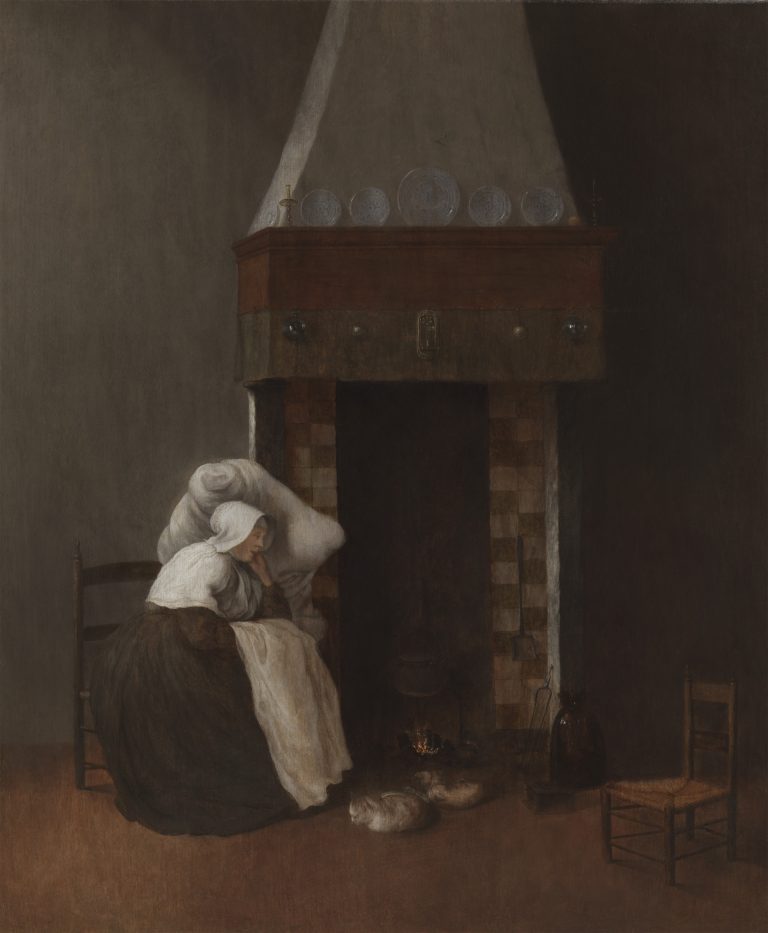This peaceful domestic scene depicts an older woman seated on a wooden chair in a sober interior, her head leaning against a large, white pillow propped up against a tall fireplace. A cat and a small dog curled up in front of the hearth comfortably enjoy the warmth emitted by its smoldering flames. To the right of the brown-and-tan tiled fireplace hangs a shovel suspended from a hook, and on the floor nearby are tongs, a dark terra cotta pot, and a foot warmer. Resting on the wooden hood of the fireplace are simple, white, earthenware plates decorated with delicate blue designs, two brass candlesticks, and a single orange. Suspended from hooks attached to the bottom of the wooden hood, from which also hangs a dark cloth skirting, is a small ornamental candleholder, symmetrically flanked by metal vessels.1 The empty chair on the right reinforces the quiet, solitary character of this woman’s life.
In 1935, Clotilde Brière-Misme identified this painting as the “sick woman sitting by a Dutch fireplace” recorded in the 1659 inventory of the art collection of Archduke Leopold Wilhelm of Austria (1614–62), governor to the Spanish Netherlands at the court in Brussels from 1647–56.2 Indeed, the pillow and the woman’s half-open eyes and slightly raised eyebrows do suggest that she is unwell.3 In the inventory this work is described as being a pendant to Jacobus Vrel’s painting of a “woman looking out of a window” (fig 1).4 The scene in the latter painting, which is in the Kunsthistorisches Museum, Vienna, is situated in a similar room with an identical fireplace. Dated 1654, it is Vrel’s earliest extant dated work. Brière-Misme’s hypothesis has been generally accepted even though the vertical dimensions of Interior with a Sick Woman by a Fireplace are substantially less than those of Woman Looking Out of a Window.5 Brière-Misme postulated that the two paintings once had identical dimensions and that Interior with a Sick Woman by a Fireplace had subsequently been cut at the top.6
Technical analysis has confirmed Brière-Misme’s hypothesis. The absence of a bevel along the top edge of the panel, as well as the small chips along this edge, indicate that the panel was cut.7 The painting’s earlier appearance is seen in a photograph taken in 1928, when it was with art dealer Van Diemen & Co in Berlin (fig 2).8 At that time the painting was about nine centimeters taller, the size difference between it and Woman Looking Out of a Window. Moreover, the versos of the Vienna and the Leiden Collection panels are remarkably similar in appearance, indicating that the panels were made by the same craftsman around the same time (fig 3).9
Even if the Leiden Collection and Vienna paintings were considered to be pendants when they were in the collection of Archduke Leopold Wilhelm, there is no proof that Vrel originally intended them as a pair. There are no other known examples in his oeuvre of pendant paintings. It is not known either how the works entered that collection, whether separately or together, or whether they came through the initiative of the archduke’s curator in Brussels, David Teniers the Younger (1610–90).10 Nevertheless, whether or not they were conceived as pendants, these two paintings complement each other in the ways they evoke the solitude of human life (fig 4).
Several old references record that the painting was once signed and dated on a piece of paper attached to the nail on the fireplace, yet no trace of this paper remains today.11 It is likely, however, that Vrel executed this work around 1654, the year in which its purported pendant was created, and certainly before 1656, the year in which Leopold Wilhelm’s term as governor of the Spanish Netherlands in Brussels ended and he returned to Vienna.12 If this date is correct, this painting and the panel in Vienna, Vrel’s earliest known dated work, were executed several years before Pieter de Hooch began painting his interior genre scenes. As Peter Sutton has suggested, Vrel seems to have “anticipated Delft artists’ interest in domestic themes.”13 It is therefore frustrating that Vrel’s origins and training remain a mystery.14 None of the simple and inexpensive objects, including the blue and white earthenware displayed on the fireplace mantle, ubiquitous throughout Europe, has shed any light on the region in which this enigmatic artist resided.
